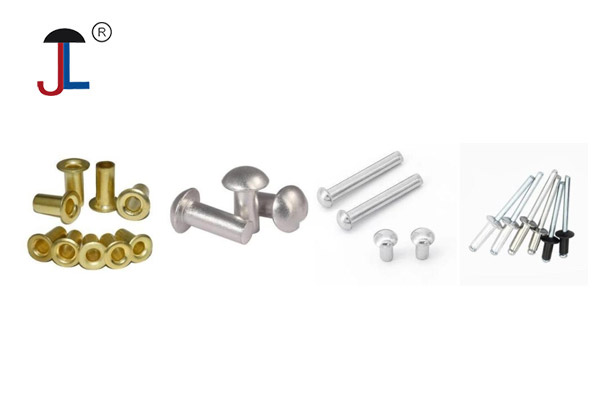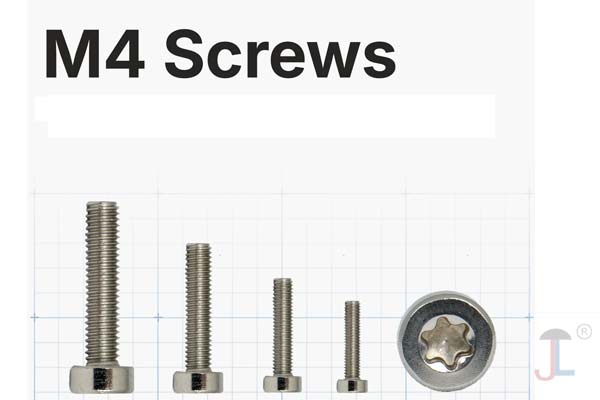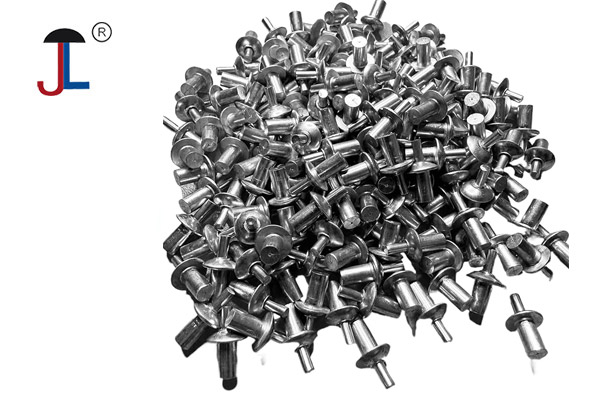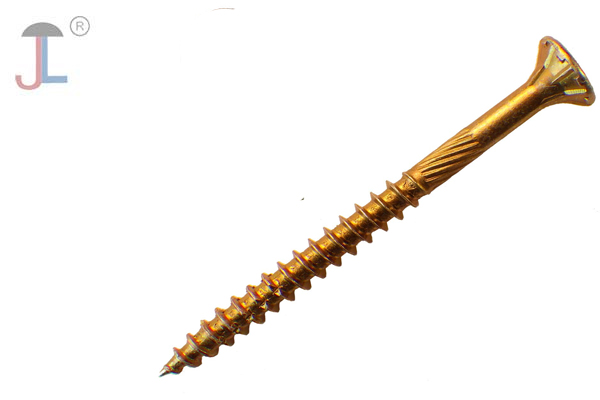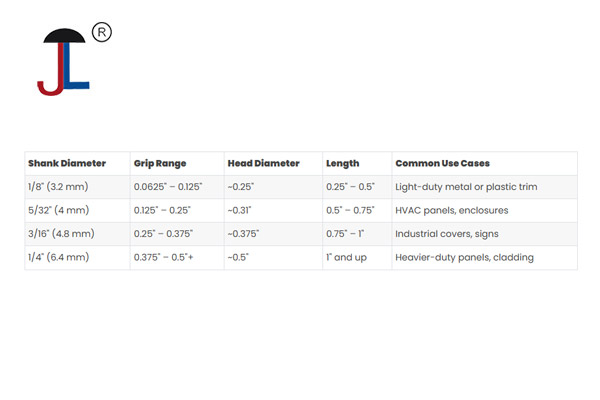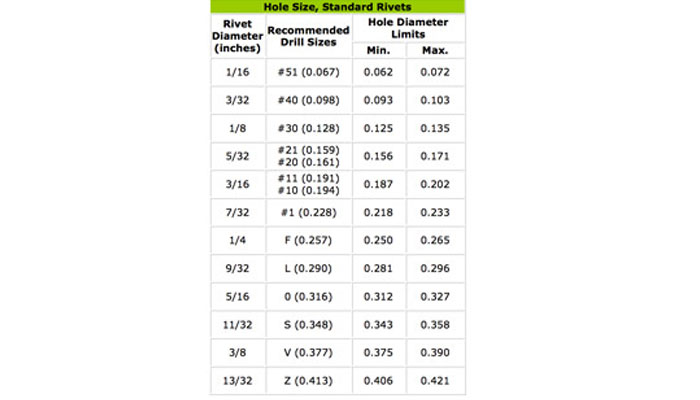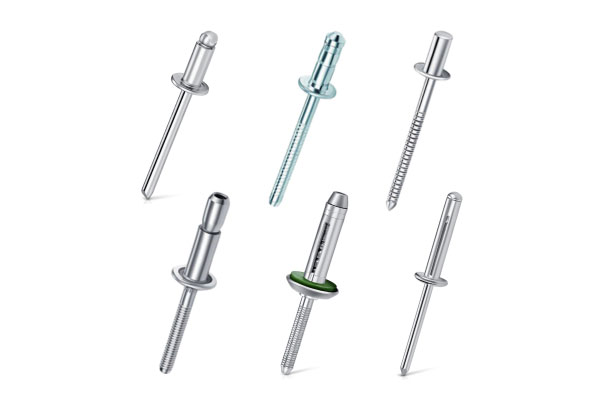
1. How Blind Rivets Work
-
Components
-
Rivet Body (Shell or Sleeve): Cylindrical outer portion made of metal (e.g., aluminum blind rivet, steel, stainless steel blind rivet, or copper blind rivet).
-
Mandrel (Stem): A long, tapered rod that runs through the rivet body. The mandrel head bears against the blind side of the materials being fastened.
-
-
Installation Mechanics
-
Hole Preparation: A hole is drilled through all layers to be joined. The hole diameter typically matches the rivet’s body diameter (e.g., a 4 mm hole for a 4 mm rivet).
-
Inserting the Rivet: The rivet body is pushed through the hole until its flange (or head) is flush against the accessible surface.
-
Pulling the Mandrel: Using a blind rivet gun or pneumatic tool, the installer pulls the mandrel toward the gun, causing the mandrel’s thicker section (just behind the mandrel head) to draw into the rivet body.
-
Forming the Blind Side: As the mandrel is pulled, the rivet body deforms (expands and flares) on the blind (hidden) side of the material, creating a secure “bulb” or “cherry” shape that clamps the materials together.
-
Mandrel Break-Off: Once adequate force is applied, the mandrel snaps at a pre-weakened breakneck point, leaving a short stump behind. The majority of the mandrel is drawn into the rivet body and discarded, while the flange and deformed body remain securing the joint.
-
2. Common Types of Blind Rivets
Blind rivets can be classified based on their head style, material, mandrel design, and special features. Below is an overview:
-
By Head Style
-
Flanged (Standard) Head
-
Most common. Offers a broad bearing surface for clamping.
-
Suitable for general-purpose fastening in thin sheet metals, plastics, and other laminates.
-
-
Countersunk (Flush) Head
-
The head sits flush or slightly recessed in the material’s surface once installed.
-
Ideal for applications requiring a smooth surface, such as furniture, boat hulls, or aesthetic panels.
-
-
Large Flange Head
-
Oversized flange provides increased bearing area, reducing the risk of rivet pull-through in soft materials (e.g., plastics, composites).
-
-
Oval Head
-
Domed head with a slightly rounded top—often used when minimal projection above the surface is desired but some bearing area is still needed.
-
-
-
By Material
-
Aluminum Body / Steel Mandrel
-
Lightweight and corrosion-resistant. Common in general-purpose applications.
-
-
Steel Body / Steel Mandrel (Zinc-Plated or Cadmium-Plated)
-
Higher strength than aluminum. Used where greater shear or tensile loads are anticipated. Zinc or cadmium plating adds rust resistance.
-
-
Stainless Steel Body / Stainless Steel Mandrel
-
Excellent corrosion resistance; suitable for marine, chemical, and outdoor applications. Slightly more expensive, but necessary where galvanic corrosion is a concern.
-
-
Monel Body / Stainless Mandrel
-
Monel is a nickel-copper alloy with outstanding corrosion resistance (especially in saltwater). Used in harsh environments.
-
-
Copper Body / Steel or Copper Mandrel
-
Occasionally used for applications requiring low-temperature conductivity or where electrical isolation is not an issue. Less common than other types.
-
-
-
By Mandrel Design / Special Features
-
Mandrel-Locking (Structural) Blind Rivets
-
After installation, the mandrel remains locked inside the body rather than breaking off. This provides extra shear and tensile strength. Commonly referred to as structural rivets.
-
-
Closed-End Blind Rivets
-
The mandrel seals the end of the rivet body, preventing fluids, gases, or fumes from passing through the rivet hole. Used for fuel tanks, HVAC ducts, or other applications requiring leak resistance.
-
-
Open-End Blind Rivets
-
Standard type where the mandrel creates the blind-side bulbing but doesn’t form a complete seal. Less expensive than closed-end.
-
-
Multi-Grip (Universal) Blind Rivets
-
Designed to accommodate a wide range of grip (material thickness) variations. A single rivet can cover several thicknesses, reducing inventory requirements. Ideal for assemblies where material thickness varies.
-
-
Sealed Blind Rivets
-
Feature a built-in washer or sealing element (e.g., EPDM rubber gasket) on the flange side to prevent water or air ingress. Often used in trailer bodies, roofing panels, and enclosures.
-
-
3. Advantages and Disadvantages of Blind Rivets
3.1 Advantages
-
Single-Sided Access: Can be installed when only one side of the assembly is accessible.
-
Speed and Ease of Use: Installation is typically fast—just drill the hole, insert the rivet, and actuate the rivet gun.
-
Consistent, Predictable Joints: Once the proper rivet and tool are chosen, installation yields uniform blind-side bulbing, ensuring consistent clamp force.
-
Corrosion Resistance: Available in materials (e.g., aluminum, stainless steel, Monel) suited for outdoor or corrosive environments.
-
Low Profile: Countersunk variants allow flush finishes, maintaining aesthetics or preventing interference.
-
Sealing Options: Closed-end and sealed rivets prevent fluid ingress, making them suitable for liquid- or gas-tight joints.
-
Lightweight: Aluminum and other non-ferrous rivets add minimal weight, a benefit in aerospace, automotive, and consumer electronics.
3.2 Disadvantages
-
Limited Re-Use: Once installed, a blind rivet is permanent. Removal requires drilling out the mandrel or cutting the rivet, often damaging surrounding materials.
-
Shear and Tensile Strength: Although adequate for many applications, blind rivets generally do not match the strength of some other fasteners (e.g., high-strength bolts or structural rivets) in heavy-load situations.
-
Aesthetic Considerations: The mandrel stump may protrude slightly from the head. While often minimal, it can be undesirable in precision or decorative applications.
-
Brittleness During Installation: Improper tool selection (e.g., low-quality rivet gun) can cause incomplete bulbing or mandrel breakage too early, leading to weak joints.
-
Cost: Specialty blind rivets (e.g., Monel, structural, sealed) can be more expensive than simpler fastening methods—especially in high volumes.
4. Common Sizing Standards
Blind rivets are sized by body diameter and grip range (material thickness they can clamp). Standards may vary by region:
-
Metric (ISO) Standards
-
Common diameters: 2.4 mm, 3.2 mm, 4.0 mm, 4.8 mm, 6.0 mm.
-
Example: A “4 × 10 mm” rivet indicates a 4 mm body diameter and 10 mm grip range.
-
-
Imperial (Fractional-Inch)
-
Sizes like 3/32″, 1/8″, 5/32″, 3/16″, etc.
-
Grip range usually given in fractions: e.g., 1/8″–1/4″.
-
-
Grip Range Determination
-
Minimum Grip: The thinnest stack of materials the rivet can clamp (too thin → rivet may not properly flare, causing “spinning” or poor clamp).
-
Maximum Grip: The thickest stack the rivet can clamp (too thick → insufficient tail to form the blind-side bulb).
-
5. Advantages vs. Other Fastening Methods
| Feature | Blind Rivet | Solid Rivet | Self-Tapping Screw | Welded Joint | Adhesive Bonding |
|---|---|---|---|---|---|
| Accessibility | One-sided access | Requires two-sided access | One-sided access | Usually two-sided or specialized | One-sided access |
| Strength (Shear/Tensile) | Moderate (varies by material) | Very high (solid rivet joints) | Moderate (thread engagement) | High (depends on weld quality) | Moderate to high (adhesive-specific) |
| Speed of Installation | Fast | Slower (requires bucking bar) | Fast | Slow (setup, prep, safety) | Moderate to slow (cure time) |
| Permanent vs. Removable | Permanent (removal destructive) | Permanent | Removable (can back out) | Permanent | Semi-permanent (surface prep needed) |
| Corrosion Resistance | Excellent if stainless/Monel chosen | Good if stainless | Varies by screw coating | Depends on filler & base metal | Depends on adhesive properties |
| Cost (Part + Tooling) | Low to Moderate | Moderate to High (labor cost) | Low (fasteners & driver bit) | High (welding equipment, labor) | Low to Moderate (adhesive & prep) |
| Aesthetic Finish | Visible head; countersunk option available | Visible head; can be flush | Visible head | Seam visibility; requires finishing | Invisible (clean finish) |
| Gap Filling | Bulb forms a small gap; limited gap filling | Solid joint; no gap | Slight compression; little gap filling | Can fill larger gaps | Excellent gap filling |
6.FAQs
-
Can I use blind rivets in structural applications?
-
Yes—structural blind rivets (mandrel-locking types) are designed for higher shear and tensile loads. However, always consult the manufacturer’s data sheet for specific load ratings and adhere to engineering guidelines.
-
-
What’s the difference between open-end and closed-end blind rivets?
-
Open-End Blind Rivets: Standard type; mandrel forms a blind-side flared head but does not seal the hole.
-
Closed-End Blind Rivets: Mandrel seals the rivet’s blind side, making the joint fluid- and gas-tight. Ideal for applications requiring a sealed assembly (fuel tanks, HVAC ducts).
-
-
How do I know if I have the correct hole size?
-
Hole diameter should match the rivet’s specified body diameter (e.g., a 4 mm rivet requires a 4 mm hole). Check the rivet packaging or datasheet. Drilling a slightly undersized hole can make insertion difficult; a slightly oversized hole reduces joint strength.
-
-
Can I remove a blind rivet without damaging the surrounding material?
-
Removal of a blind rivet is destructive: you must drill or grind off the head and then punch out the body. This can enlarge or deform the hole. If hole integrity is critical, consider using a threaded insert or reaming/repair after removal.
-
-
What safety precautions should I take when installing blind rivets?
-
Wear safety glasses to protect against flying mandrels.
-
Use hearing protection if using loud pneumatic or hydraulic tools.
-
Wear gloves when handling sharp-edge materials and spent mandrel stubs.
-
Secure workpieces firmly to prevent sudden movement.
-
-
Why does my blind rivet spin in the hole?
-
Likely an oversized or poorly drilled hole. Ensure correct drill bit size and avoid wobble. In soft materials, use large-flange or serrated-flange rivets to improve grip.
-
-
Are there blind rivets with vibration resistance?
-
Yes—some rivets incorporate specially designed mandrels or body shapes that resist loosening under vibration. Look for rivets marketed specifically as “vibration-resistant” or “vibration-proof.”
-

